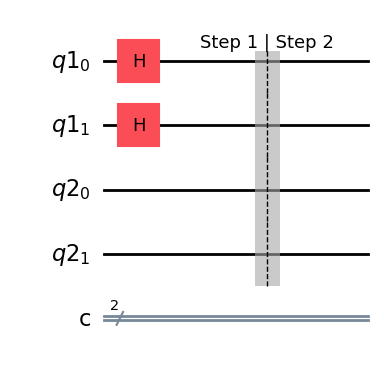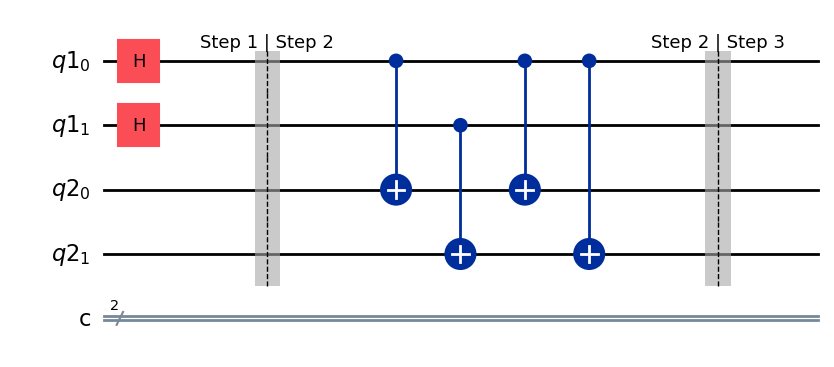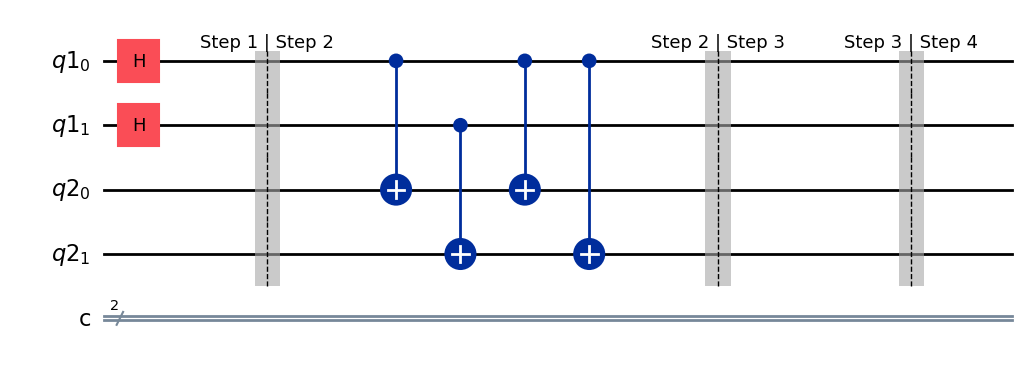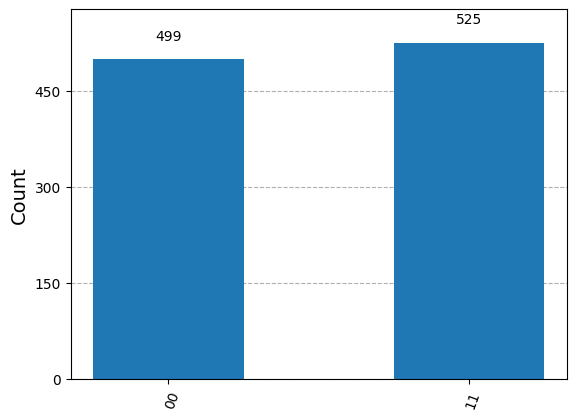from typing import *
import time
import random
import numpy as np
import matplotlib.pyplot as plt
from qiskit_aer import AerSimulator
from qiskit.quantum_info import Statevector, Operator
from qiskit.visualization import plot_histogram, plot_bloch_multivector
from qiskit import QuantumCircuit, QuantumRegister, ClassicalRegister
sim = AerSimulator()
from util import zero, one, enum_bits
QC: Simon’s Algorithm#
Simon’s Algorithm was the first quantum algorithm to demonstrate exponential speedup compared to classical probabilistic algorithm. Thus, it improves upon Deutch-Jozsa and gives hope that there are a class of problems that can be solved with a quantum computer that cannot be solved with a classical computer.
References
Problem Formulation#
Simon’s algorithm solves the problem of determining whether a function is one-to-one or two-to-one. Similar to Deutsch-Jozsa, Simon’s algorithm solves a somewhat contrived problem whose main utility is in showing that it is possible for a quantum algorithm to achieve exponential speedup compared to a classical algorithm.
One-to-one function#
A function \(f: \{0, 1\}^n \rightarrow \{0, 1\}^n\) is one-to-one if
iff \(x = y\), i.e., it maps unique bitstrings to unique bitstrings.
# one-to-one
def neg_all(x: list[bool]) -> list[bool]:
return [not b for b in x]
print(neg_all([False, False]))
print(neg_all([False, True]))
print(neg_all([True, False]))
print(neg_all([True, True]))
[True, True]
[True, False]
[False, True]
[False, False]
# not one-to-one
def f(x: list[bool]) -> list[bool]:
return [x[len(x)-1]] + [x[i] and x[i+1] for i in range(len(x)-1)]
print(f([False, False])) # <- non-unique
print(f([False, True]))
print(f([True, False])) # <- non-unique
print(f([True, True]))
[False, False]
[True, False]
[False, False]
[True, True]
Two-to-one function#
A function \(f: \{0, 1\}^n \rightarrow \{0, 1\}^n\) is two-to-one if for every unique output \(z\),
for exactly two \(x \neq y\), i.e., it maps each pair of unique bit-strings to the same output.
Equivalent formulation#
Equivalently, let \(b \in \{0, 1\}^n \neq 0\) be a bit string. Then \(f\) is two-to-one if \(f(x) = f(y)\) iff \(y = x \oplus b\).
Note that \(b = 0\dots0\) corresponds to the case that f is a one-to-one function.
def mk_two2one_nbit(n) -> list[bool]:
b = [True] + [random.choice([True, False]) for i in range(n-1)]
xs = enum_bits(len(b))
out = enum_bits(len(b)); random.shuffle(out); i = 0
mapping = {}; seen = set()
for x in xs:
y = [c != d for c, d in zip(x, b)]
sx = str(x); sy = str(y);
if sx in seen or sy in seen:
continue
mapping[sx] = out[i]; mapping[sy] = out[i]; i += 1
seen.add(sx); seen.add(sy)
return lambda x: mapping[str(x)]
g2 = mk_two2one_nbit(2)
print(g2([False, False]))
print(g2([False, True]))
print(g2([True, False]))
print(g2([True, True]))
[True, True]
[True, False]
[True, False]
[True, True]
g3 = mk_two2one_nbit(3)
for b in enum_bits(3):
print(g3(b))
[False, False, False]
[False, True, False]
[False, True, False]
[False, False, False]
[True, True, True]
[True, False, False]
[True, False, False]
[True, True, True]
Simon’s Problem Formulation#
Simon’s problem is: given a function on bitstrings \(f : \{0, 1\}^n \rightarrow \{0, 1\}^n\) that is either
a one-to-one function or
a two-to-one function,
determine whether it is a one-to-one function or a two-to-one function. Equivalently, given a hidden bit string \(b\), determine if \(b\) is all 0s or not.
Classical Solution#
Intuitively, the simplest thing we can do is to check every input and see if we get a one-to-one function or a two-to-one function. We actually “only” need to check one more than half of the inputs since we’re dealing with two-to-one functions.
def solve_simons(nbits: int, f: Callable[list[bool], list[bool]]) -> str:
seen = set()
inputs = enum_bits(nbits)
count = 0
for b in inputs:
# We only need to check half the inputs
if count >= len(inputs)/2 + 1:
break
count += 1
# Keep track of what we have seen
y = str(f(b))
if y in seen:
return "two-to-one"
seen.add(y)
return "one-to-one"
solve_simons(3, neg_all)
'one-to-one'
ns = range(4, 18)
times = []
for n in ns:
start = time.time()
gn = mk_two2one_nbit(n)
solve_simons(n, gn)
times += [time.time() - start]
plt.plot(ns, times)
plt.xlabel('Number of bits'); plt.ylabel('Time (sec)'); plt.title('Running Time of Classical Algorithm')
Text(0.5, 1.0, 'Running Time of Classical Algorithm')

Aside: Probabilistic Solution to Simon’s Problem#
Unlike the Deutsch-Jozsa problem, it is still hard for us to get a speedup, even if we allowed for some error. Intuitively, we still need to check half the bit-strings (in the worst case since the two-to-one can be adversarially constructed), which would still take exponential time.
Quantum Solution#
In this section, we’ll walkthrough Simon’s algorithm. Simon’s algorithm provides an efficient solution to distinguishing between two-to-one or one-to-one functions.
Walkthrough#
We’ll use a two qubit example. It will be helpful to separate the initial state
into two parts.
b = "11"
n = len(b)
part1 = QuantumRegister(n, "q1")
part2 = QuantumRegister(n, "q2")
output = ClassicalRegister(n, "c")
simon_circuit = QuantumCircuit(part1, part2, output)
simon_circuit.draw(output="mpl", style="iqp")

Step 1: Put first n qubits in superposition#
Our first step is to the first \(n\) qubits in superposition. Towards this end, we apply \(H^{\otimes n} = \frac{1}{\sqrt{2^n}} \sum_{x \in \{0, 1\}^n} \sum_{y \in \{0, 1\}^n}(-1)^{x \cdot y} |x\rangle\langle y|\) to the first \(n\) qubits.
# Step 1: Apply Hadamard gates to first n qubits
simon_circuit.h(range(n))
simon_circuit.barrier(label="Step 1 | Step 2")
simon_circuit.draw(output="mpl", style="iqp")

State after step 1#
After we apply step 1, we have the following quantum state
Step 2: Apply Oracle#
Apply the oracle
# Source: https://github.com/qiskit-community/qiskit-textbook/blob/589c64d66c8743c123c9704d9b66cda4d476dbff/qiskit-textbook-src/qiskit_textbook/tools/__init__.py
def simon_oracle(b):
"""returns a Simon oracle for bitstring b"""
b = b[::-1] # reverse b for easy iteration
n = len(b)
qc = QuantumCircuit(n*2)
# Do copy; |x>|0> -> |x>|x>
for q in range(n):
qc.cx(q, q+n)
if '1' not in b:
return qc # 1:1 mapping, so just exit
i = b.find('1') # index of first non-zero bit in b
# Do |x> -> |s.x> on condition that q_i is 1
for q in range(n):
if b[q] == '1':
qc.cx(i, (q)+n)
return qc
oracle = simon_oracle(b)
# Step 2: Query Oracle
simon_circuit = simon_circuit.compose(oracle)
simon_circuit.barrier(label="Step 2 | Step 3")
simon_circuit.draw(output="mpl", style="iqp")

After step 2#
After we apply the oracle, we have the following quantum state
Observe that we have now encoded the result of the oracle as part of a computational basis vector.
Step 3: Measure second n qubits#
Measure the second half of \(|\psi_2\rangle\) to obtain \(f(x)\).
# Can only measure at the end in qiskit
simon_circuit.barrier(label="Step 3 | Step 4")
simon_circuit.draw(output="mpl", style="iqp")

After step 3#
After measuring the second half of \(|\psi_2\rangle\) to obtain \(f(x)\), this means either \(x\) or \(y = x \oplus b\) could be the corresponding input. Therefore the first half of \(|\psi_2\rangle\) becomes
so that the entire quantum state is
Step 4: Prepare for measurement#
Apply \(H^{\otimes n} = \frac{1}{\sqrt{2^n}} \sum_{x \in \{0, 1\}^n} \sum_{y \in \{0, 1\}^n}(-1)^{x \cdot y} |x\rangle\langle y|\) to the first \(n\) qubits, i.e., \(|\psi_3\rangle\) to prepare for measurement.
simon_circuit.h(range(n))
simon_circuit.barrier(label="Step 4 | Step 5")
simon_circuit.draw(output="mpl", style="iqp")

State after step 4#
After step 4, we obtain the following quantum state
We have “leaked” the dot product \(w \cdot x\) and \(w \cdot y\) into the phase of \(|\psi_4\rangle\).
Step 5: Measure first n qubits#
The last step in the algorithm is to measure the first n qubits.
simon_circuit.measure(range(n), range(n))
simon_circuit.draw(output="mpl", style="iqp")

Interpreting the results#
Observe:
\((-1)^{w \cdot x} = (-1)^{w \cdot y}\): contribution of corresponding \(|a\rangle\)
\((-1)^{w \cdot x} \neq (-1)^{w \cdot y}\): no contribution of corresponding \(|w\rangle\)
Consequently, upon a single measurement, we will observe some \(|w\rangle\) s.t. \(w \cdot x = w \cdot y\). This occurs
Thus with \(\approx n\) queries, we obtain a system of linear equations
This can be solved in \(O(n^3)\) time.
# Calculate the dot product of the results
def bdotz(b, z):
# Source: https://qiskit.org/textbook/ch-algorithms/simon.html
accum = 0
for i in range(len(b)):
accum += int(b[i]) * int(z[i])
return (accum % 2)
results = sim.run(simon_circuit, shots=1024).result()
counts = results.get_counts()
for z in counts:
print("{}.{} = {} (mod 2)".format(b, z, bdotz(b,z)))
plot_histogram(counts)
11.00 = 0 (mod 2)
11.11 = 0 (mod 2)

Putting it together#
We provide the full algorithm below.
def simons(b: str) -> QuantumCircuit:
n = len(b)
oracle = simon_oracle(b)
part1 = QuantumRegister(n, "q1")
part2 = QuantumRegister(n, "q2")
output = ClassicalRegister(n, "c")
simon_circuit = QuantumCircuit(part1, part2, output)
# Step 1: Apply Hadamard gates to first n qubits
simon_circuit.h(range(n))
simon_circuit.barrier(label="Step 1 | Step 2")
# Step 2: Query Oracle
simon_circuit = simon_circuit.compose(oracle)
simon_circuit.barrier(label="Step 2 | Step 3")
# Step 3: Can only measure in qiskit at the end, but these results are ignored
simon_circuit.barrier(label="Step 3 | Step 4")
# Step 4: Apply Hadamard gates to first n qubits
simon_circuit.h(range(n))
simon_circuit.barrier(label="Step 4 | Step 5")
# Step 5: Measure first n qubits
simon_circuit.measure(range(n), range(n))
return simon_circuit
simon_circuit2 = simons("10")
simon_circuit2.draw(output="mpl", style="iqp")

results = sim.run(simon_circuit, shots=1024).result()
counts = results.get_counts()
for z in counts:
print("{}.{} = {} (mod 2)".format(b, z, bdotz(b,z)))
plot_histogram(counts)
11.11 = 0 (mod 2)
11.00 = 0 (mod 2)

Summary#
The classical algorithm for solving Simon’s problem requires an exponential number of queries.
The quantum algorithm for solving Simon’s problem requires just a single query.
Simon’s algorithm is contrived. Nevertheless, it inspired Shor’s algorithm, which is useful.
